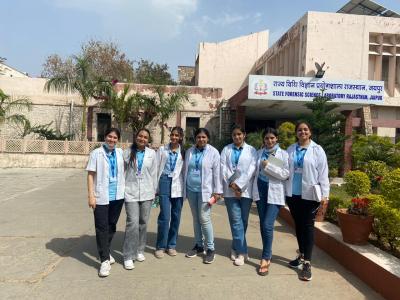REPORT ON VISIT TO STATE FORENSIC SCIENCE LABORATORY, JAIPUR

On February 21, 2024, a group of 30 students from the Department of Zoology, IIS (deemed to be University) in Jaipur had the exciting opportunity to visit the State Forensic Science Laboratory. They were accompanied by Dr. Lata Shahani, Head of the Zoology Department and Prof. Priyanka Mathur. Their main goal was to get a practical understanding of how different branches of forensic science work and their role in solving crimes and ensuring justice. The visit was divided into three main areas: Biological Sciences, Chemical Sciences, and Physical Sciences, with each area giving them valuable insights into various aspects of forensic investigations.
The Forensic Science Department's biology section highlighted the critical role of DNA analysis in various criminal investigations, including rape, murder, newborn exchange, and human trafficking cases. The students were introduced to the basics of DNA structure and its role as the genetic blueprint of living organisms. They were educated on techniques like polymerase chain reaction (PCR) and DNA sequencing, essential for extracting, amplifying, and analyzing DNA samples. Additionally, the department illustrated the process of comparing DNA profiles to pinpoint suspects and establish connections to crime scenes. The students were also explained in detail about the investigations carried out by the FSL team.
In the chemistry section, students learned about techniques like chromatography and spectroscopy, which are used to identify and analyze substances found at crime scenes. The department demonstrated how chemical analysis can provide important evidence in cases involving arson, drug-related crimes, and toxic substances. Specific attention was given to analyzing excise substances (like alcohol and tobacco), explosives, and narcotics. Students were shown how sophisticated equipment and chemical tests are employed to identify and analyze these substances. They also learned about narcotics classification, detecting explosive residues, and examining alcohol levels in cases such as drink-driving incidents.
Then toxicology section focused on the detection and analysis of drugs and toxins in biological samples. Students were introduced to the processes involved in toxicology testing, including sample preparation, extraction, and instrumental analysis. They learned about the effects of drugs on the human body, drug metabolism, and the importance of toxicology in determining cause of death and detecting drug-related crimes.
The ballistics section provided insights into the analysis of firearms and their ammunition. Students learned about the examination of bullets, cartridge cases, and gunshot residues. The experts explained the principles of ballistics and how the examination of firearm-related evidence can help determine the type of weapon used and establish links between suspects and crime scenes.
The computer forensics section focused on the examination and analysis of digital evidence. Students learned about the tools and techniques used to recover and analyze data from computers, mobile devices, and other digital media. They also learned the importance of data integrity, digital evidence preservation, and the role of computer forensics in solving cybercrimes and retrieving valuable information for criminal investigations.
The field trip to the Forensic Science Department offered students a comprehensive understanding of forensic science's branches and their role in crime-solving. It provided valuable insights into biological, chemical, and physical sciences' contributions to investigations. The department's infrastructure was impressive, with well-equipped labs for various analyses like DNA testing and ballistics examination, highlighting their commitment to technological advancement. Safety measures were rigorously followed, ensuring lab safety. Administrative facilities were well-maintained, supporting smooth operations. The visit facilitated networking with professionals, fostering potential collaborations and inspiring research ideas. Overall, it was an enriching experience, enhancing students' understanding and potential for future research in forensic science.

